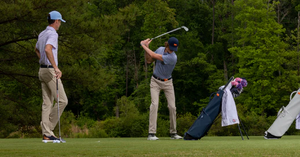Why Am I Shanking My Irons?
Golf requires levels of patience and precision that rival that of surgeons. As all successful players know, golf demands intentional focus and attention to detail. Otherwise, the slightest movement out of line could mean devastation on the course.
A word that makes all golfers quake and grimace is “shanking.” Many pros and even intermediate players consider it one of the worst things that can happen during a round of golf.
Here, we cover what a shank is, why it occurs, and how to prevent it from happening so that you can save yourself embarrassment at your local club. Arm yourself with this knowledge and play with more consistency and confidence.
What is a Golf Shank?
A golf shank is a common mistake. While often mortifying if it happens in front of colleagues or peers, all golfers will inevitably shank their iron at least once.
A shank occurs when you’ve failed to line up your swing correctly. When your club meets the ball, the ball bounces off of the hosel (where the shaft connects to the clubhead) instead of striking the clubface. Another way to think of a golf shank is to think of it as hitting the hosel of your club.
The ball will ricochet off to the right when a shank happens instead of soaring in the intended direction. Typically, it doesn't make it very far either.
A shank is every golfer's nightmare. It has the massive potential to ruin a great round for the player, often to the extent that makes a recovery all but impossible. And while we don't think there's any shame in this mishap, it definitely can deflate confidence on the course.
What Causes a Shank?
The best way to prevent a shank from happening is to understand how it can occur in the first place. While sometimes a shank may just happen—call it a bout of bad luck—there are typically identifiable reasons for a shank.
Go through this checklist of reasons so that you can identify what went wrong and prevent it from happening in future rounds.
The Club Is Too Far Inside During Your Backswing
Pro golfers know that alignment is everything. That's why you see players carefully scrutinizing the ball's position, demanding absolute focus to line everything up properly. If things are a bit off, a shank could be the result.
It may be challenging to recover if a golfer takes their club too far inside on the backswing. This shift out of alignment creates a wide swing path. On impact, when the club hits the ball, you can feel right away that the swing was too far on the side.
Swing Path Is Off
Typically, players hit the ball in a motion that takes the club from inside to out of the ball-to-target line. But sometimes, a golfer flubs up and pulls the club away from the swing path.
To recover, they end up coming over the top of it, making them swing outside to inside instead of the coveted inside to out. When this series of events occurs, it's common for the ball to make contact with the hosel and bounce off to the right.
Poor Grip
Another thing to pay attention to is grip pressure. When it comes to gripping your club, you need to find the Goldilocks “just right” level of tension on your club to send the ball soaring in your direction of choice.
It is common for golfers to hold their clubs too lightly. With this mistake, the club has the potential to move in their hands during their swing.
If your club shifts, it's challenging to control precisely where the clubface will contact the ball. While you may get lucky and make a proper impact, it's more of a gamble, and you run the risk of shanking.
Your Weight Is on Your Toes
The average amateur male player's swing is over 93 miles per hour. When you think about hurling a heavy piece of metal through the air at that speed, you realize how stable your base needs to be to prevent the player from flying off-balance after their club.
Golfers must have their weight evenly distributed in their feet during a swing. If a golfer is leaning too far forward with their weight on their toes, they risk messing up their swing and shanking. Not only that, but they run the risk of physical injury as well.
Your Stance Is Off
Not only is weight distribution in the feet important, but the distance between your feet and the ball also matters. If you are leaning far forward so that your hands aren't in line with your body when you swing, there's a good chance you're going to hit a shank.
Downswing Slide
Another common cause of a shank is a lower-body downswing slide. This movement occurs when the lower body shifts too much during the downswing.
While the intention may be positive, such as using all your force to drive the ball further, you may be setting yourself up for a shank, forcing the hosel to contact the ball before the clubface.
How Do I Stop Shanking My Golf Clubs?
While shanking is a common mistake, there are fortunately some easy fixes. If you focus on these elements when setting up for a shot, you'll minimize your chance of hitting a shank.
Fix Your Stance and Posture
Your body should be in alignment from the top of your head to your toes to hit a good shot. Make sure your weight is evenly distributed in your feet to stay securely planted to the ground. Keep a slight bend in your knees, never locking them out.
If you feel like you have to reach forward for the ball, you need to adjust your stance and move closer. You should not be bending over, and your arms should remain close to your body but not cramped. Good posture will serve you well in preventing a shank.
Posture is crucial for your swing overall and your rotation. Poor posture also has concerning impacts on health. Fortunately, doing exercises that can improve your posture can improve your golf game and general physical fitness.
Check Your Grip
Make sure you have a proper grip on your club. You don't want to clutch it too tightly, but there should be no room for the club to shift during your swing.
A great way to test this on the course is a grass check! Put a few blades of grass between the butt of your club and your hand. If the grass slips out of place during your swing, your grip is too loose.
Line up Your Hands
Make sure your hands are in alignment with your target during impact. The back of your left hand and the palm of your right hand should align with where you want the ball to go.
Conclusion
Over 3 million people played golf for the first time in 2021. With so many newcomers to the sport, seeing shanks on the course is inevitable. But with some intentional practice and awareness of what causes shanks, this common mistake can be prevented by rookies and veterans alike.
Are you ready to swing like a pro and show up to the course looking like one, too? Shop STITCH today for apparel, gear, and accessories for golfers designed by golfers.


